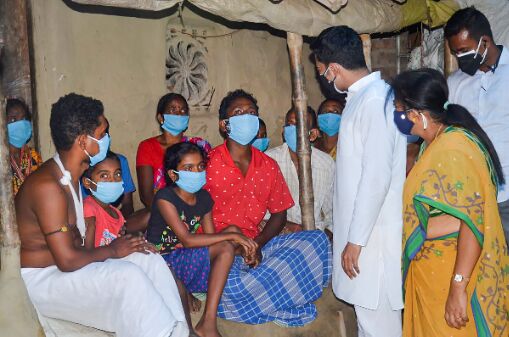Wrath of nature?
Over-exploitation of natural resources by corporate-politician nexus has lethal and disproportionate repercussions on the rural communities

The death of at least 27 people in different districts of West Bengal due to lightning on June 8 after the devastation caused by Yaas amid the pandemic is a clear warning sign from the nature which is being destroyed to fulfil our greed. Collusion between corporate and politicians has led to over-exploitation of nature in the name of development. Their profit-maximising approach and use of comforts like AC, vehicle, washing machine etc. are being aspired for and replicated by the middle class, leading to more greenhouse emissions. During my stay at village, I observed that the poor are investing money to purchase mobile phones, TV, beauty products and two-wheelers even though there is lack of nutritious food and study materials for children. The manufacturers know very well how to lure common people to buy these products. These are the very people who are the worst sufferers of disasters.
The tall promises of world leaders and engagement of bureaucrats, scientists, engineers and many other experts from different fields at a huge financial cost to control environmental problems have failed to deliver the desired results. A critical view will show that even the top-level officers who are working for the control of pollution fail to accommodate their lives in a way that will reduce greenhouse gas emissions. In Bengali, there is one proverb "Apani achari dharma, apare shekhao" (you do it first, then teach the others). But, in reality, it is just the reverse.
The top-level officers and politicians are quite reluctant to think about the consequences of environmental problems as they are well-protected within their houses. The people who died due to the lightning were from poor families and were bound to work on open agricultural fields to sustain their livelihood despite the possibility of thunderstorm and lightning. Of course, they were just in the wrong place at the wrong time. There was a very heavy sky, a flash and then the rumble.
All senior citizens, while discussing the issue, strongly advocate that such mishaps are rapidly augmented over time because they never heard of so many deaths due to lightning in their lifetime. A general conviction among people is that it happened due to sinful acts of those people or their close relatives. Their perception reminds us of Greek mythology — Zeus had dominion over the creation of lightning. It is high time to convince common people and remind them scientifically that illegal activities of the corporates in collusion with politicians, bureaucrats and top-level officers are responsible for these unnatural deaths.
Generally, in rural places, people are not aware of the danger of lightning. When there is a possibility of rain, people tend to find shelter under a nearby tree or inside a small hut or shed. People, who stand under the tree, are likely to lean on the tree and touch each other. When lightning strikes the tree, the person having contact with the tree will be affected by the touch voltage, at the same time, transmitting the touch voltage to those in physical contact. In the second case, casualty occurs when people take shelter inside a hut, thatched roof, shed etc. The houses are generally very small. People are likely to touch the sidewalls and each other.
Convective activity is one of the most fundamental meteorological phenomena that play an important role in the atmospheric, energetic and hydrological cycle. Lightning is an electrical discharge that occurs within a thunderstorm. Its visual manifestation is a crack in the sky, and occurs when certain conditions are met. Particles in a cloud rub together, gathering opposite charges that eventually separate into positive and negative regions. These two poles create a space across which a transfer of charge — or lightning bolt — may occur. Sometimes, the bolts transmit the charge to the ground and lightning strikes. The amount of lightning generated is reported to be influenced by factors that go beyond natural meteorology, including aerosols. Recent studies have given credence to the idea that more intense lightning is connected with aerosol sources over land. Cloud droplets form when water vapour condenses onto aerosols. If there are lots of aerosols, there are more condensation sites so the water is distributed among them to make smaller droplets. These little droplets are especially light and so it is easier for those to rise to higher levels of the cloud on thermal updrafts. They eventually freeze partially, forming what's known as graupel and tend to become negatively charged, and begin colliding with ice crystals (positively charged) floating in the cloud, causing the lightning.
Though the microphysics of charge separation and lightning generation due to the increase of aerosol formation is still not fully understood, scientists have advocated that the increasing trend of aerosol concentrations could enhance lightning activities. For supplementing this view, scientists advocated that where aerosol concentration is not increased appreciably in the last few years the enhancement in convective activity and lightning is controlled by thermodynamic effect. Due to the increase in global temperature, meteorologists believe that lightning and thunderstorms will become more common, killing more people in the developing world. Unfortunately, these fatalities get less attention from the media and the government.
There is an emergent need to improve early warning systems for preventing deaths resulting from lightning. To serve the purpose, financial investment in science and technology is needed to set up communication channels with the poor and vulnerable who are at high risk. State governments should consider introducing lightning arresters, lightning conductors and other infrastructure in rural areas. Emphasis must be given on educating the public, particularly in rural areas, to prevent deaths from lightning. A concerted effort to highlight the risk of this hazard and promote affordable mitigation measures in developing countries is urgently needed.
The writer is a former Senior Scientist, Central Pollution Control Board. Views expressed are personal



